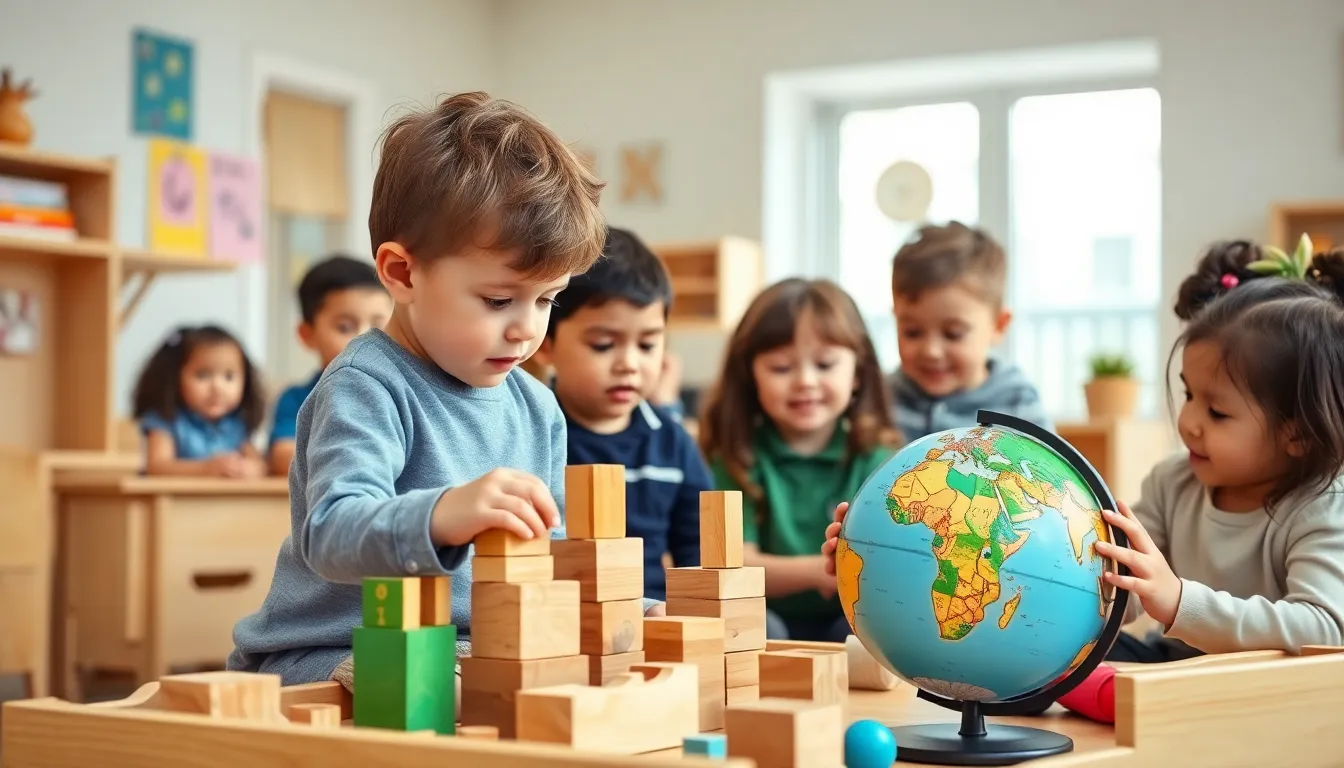Table of Contents
ToggleImagine a classroom where kids aren’t just sitting quietly, but exploring, creating, and learning at their own pace. Welcome to the Montessori approach, where education feels less like a chore and more like an adventure. Founded by Dr. Maria Montessori, this method champions child-led learning, allowing children to dive deep into their interests while developing essential life skills.
Overview Of The Montessori Approach
The Montessori approach emphasizes child-led learning in a supportive environment. Dr. Maria Montessori founded this educational philosophy, aiming to foster independence and a lifelong love for learning.
History And Origins
Dr. Maria Montessori developed her educational methods in the early 1900s in Italy. Observing children’s natural learning patterns drove her to create a child-centered environment. The first Montessori school, Casa dei Bambini, opened in 1907 in Rome. This innovative approach gained international recognition and spread across various countries. By focusing on the needs and interests of children, Montessori reshaped perceptions of education.
Key Principles
Child autonomy stands at the core of the Montessori approach. Children choose their activities, allowing personalized learning experiences. Mixed-age classrooms encourage collaboration, fostering social skills and mentorship. Hands-on learning materials promote discovery and critical thinking, enabling deeper engagement. Teachers act as guides rather than traditional instructors, creating a nurturing atmosphere. Respect for the child plays a significant role, acknowledging their individual development and interests.
Benefits Of The Montessori Approach

The Montessori approach offers numerous benefits that enhance a child’s learning experience. Two key advantages stand out: individualized learning and the development of independence.
Individualized Learning
Individualized learning forms the cornerstone of the Montessori approach. Each child engages in activities tailored to their interests and developmental readiness. This customization fosters an environment where learners thrive, as they explore topics at their own pace. Teachers, acting as guides, observe and assess children’s strengths and challenges. They facilitate access to resources that encourage self-directed exploration. Data shows children within Montessori settings often outperform peers in traditional classrooms on measures of academic achievement. School-year outcomes reflect heightened motivation and deeper engagement as individuals take charge of their learning journeys.
Development Of Independence
The development of independence significantly influences a child’s growth within the Montessori framework. Children choose their tasks, which fosters a sense of ownership and responsibility. This autonomy promotes decision-making skills as they learn to manage their time and resources effectively. Rather than following rigid instructions, children engage with materials and environments that encourage exploration and problem-solving. Studies indicate that children who experience Montessori education exhibit increased self-confidence and resilience. They become adept at tackling challenges and pursuing their interests, ensuring lifelong learning habits.
How The Montessori Approach Works
The Montessori approach emphasizes a carefully prepared environment that fosters exploration and learning. Classrooms feature specific learning materials arranged to encourage independence and concentration. Children access resources tailored to their developmental stages, promoting engagement with hands-on activities. This layout allows them freedom of choice, which builds autonomy and responsibility. Aesthetic and orderly settings, often including natural materials and open spaces, support children’s curiosity and discovery.
Learning Environment
The learning environment plays a crucial role in the Montessori approach. Classrooms feature mixed-age groups, encouraging collaboration, social interaction, and peer learning. Children benefit from observing and helping each other, fostering community and empathy. Specific learning stations offer various activities, such as practical life skills, sensory exploration, and academic subjects. The thoughtfully designed environment invites self-directed exploration, allowing children to pursue their interests at their own pace. As they engage with materials, they develop critical thinking and problem-solving abilities, laying the groundwork for lifelong learning.
Role Of The Educator
Educators assume distinct roles within the Montessori framework. Instead of traditional instructors, they act as guides and observers, facilitating rather than dictating learning. Teachers prepare the environment and introduce materials while closely monitoring each child’s progress. Individualized support ensures that children receive the guidance needed for independent exploration. They also foster a nurturing atmosphere by encouraging questions, which promotes deeper understanding. By observing children’s interests and skills, educators can tailor their approach, enhancing engagement and motivation in the learning process. This dynamic relationship between student and educator creates a supportive foundation for growth and development.
Comparing Montessori To Traditional Education
The Montessori approach contrasts significantly with traditional education methods.
Differences In Methodology
Classroom environments differ greatly between the two approaches. Montessori classrooms promote autonomy, with children selecting their activities, while traditional classrooms often rely on structured lessons directed by teachers. Teachers in Montessori settings act as guides, supporting exploration rather than lecturing. In contrast, traditional educators typically lead instruction with a focus on standardized curriculum delivery. Mixed-age groupings in Montessori foster collaboration and mentorship, unlike the age-segregated classes in traditional systems, which can limit social interactions and peer learning opportunities. Emphasis on hands-on learning materials in the Montessori method engages students actively, while traditional approaches may prioritize textbook learning and rote memorization.
Outcomes For Students
Student outcomes also show marked differences between the two educational philosophies. Research indicates that children in Montessori settings often outperform peers academically, showcasing enhanced motivation and deeper understanding of subjects. They excel in problem-solving, thanks to the emphasis on critical thinking and independence. Self-confidence and resilience frequently develop in Montessori-educated children, fostering a strong sense of ownership over their learning. Traditional students, while they may achieve standardized test scores, often require more guidance in decision-making and exploring personal interests. More importantly, the lifelong learning habits cultivated in Montessori environments better equip students for future challenges compared to their traditionally educated counterparts.
The Montessori approach revolutionizes education by prioritizing child-led learning and fostering independence. Its unique environment nurtures curiosity and critical thinking while allowing children to engage deeply with their interests. Through individualized learning experiences and collaborative mixed-age classrooms, students develop essential life skills that prepare them for future challenges.
Montessori education not only enhances academic performance but also cultivates self-confidence and resilience. As this method continues to gain recognition worldwide, it stands as a testament to the power of respecting children’s natural learning processes. Embracing the Montessori philosophy can transform educational experiences and instill a lifelong love for learning in every child.





